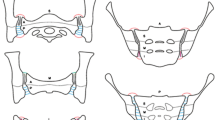Abstract
Objective
The aim of this study is to determine the added diagnostic value of contrast-enhanced (CE) magnetic resonance imaging (MRI) compared to routine non contrast-enhanced MRI to detect active sacroiliitis in clinically juvenile spondyloarthritis (JSpA).
Materials and methods
A total of 80 children clinically suspected for sacroiliitis prospectively underwent MRI of the sacroiliac (SI) joints. Axial and coronal T1-weighted (T1), Short-tau inversion recovery (STIR) and fat-saturated T1-weighted gadolinium-DTPA (Gd) contrast-enhanced (T1/Gd) sequences were obtained. The presence of bone marrow edema (BME), capsulitis, enthesitis, high intra-articular STIR signal, synovial enhancement and a global diagnostic impression of the MRI for diagnosis of sacroiliitis was recorded.
Results
STIR and T1/Gd sequences had 100 % agreement for depiction of BME, capsulitis and enthesitis. High intra-articular STIR signal was seen in 18/80 (22.5 %) patients, 15 (83 %) of whom also showed synovial enhancement in the T1/Gd sequence. Sensitivity (SN) and specificity (SP) for a clinical diagnosis of JSpA were similar for high STIR signal (SN = 33 %, SP = 85 %) and T1/Gd synovial enhancement (SN = 36 %, SP = 92 %). Positive likelihood ratio (LR+) for JSpA was twice as high for synovial enhancement than high STIR signal (4.5 compared to 2.2). Global diagnostic impression was similar (STIR: SN = 55 %, SP = 87 %, LR + =4 .2; T1/Gd: SN = 55 %, SP = 92 %, LR + = 6.9).
Conclusion
MRI without contrast administration is sufficient to identify bone marrow edema, capsulitis and retroarticular enthesitis as features of active sacroiliitis in juvenile spondyloarthritis. In selected cases when high STIR signal in the joint is the only finding, gadolinium-enhanced images may help to confirm the presence of synovitis.







Similar content being viewed by others
References
Burgos-Vargas R. The juvenile-onset spondylarthritides. Rheum Dis Clin North Am. 2002;28(3):531–60.
Colbert RA. Classification of juvenile spondyloarthritis: enthesitis-related arthritis and beyond. Nat Rev Rheumatol. 2010;6(8):477–85.
Petty RE, Southwood TR, Manners P, et al. International League of Association for Rheumatology Classification of juvenile idiopathic arthritis: second revision. Edmonton 2001. J Rheumatol. 2004;31(2):390–2.
Lambert RG, Salonen D, Rahman P, et al. Adalimumab significantly reduces both spinal and sacroiliac joint inflammation in patients with ankylosing spondylitis: a multicenter, randomized, double-blind, placebo-controlled study. Arthritis Rheum. 2007;56(12):4005–14.
Tse SML, Laxer RM. New advances in juvenile spondyloarthritis. Nat Rev Rheumatol. 2012;8:269–79.
Baraliakos X, Haibel H, Listing J, Sieper J, Braun J. Continuous long-term anti-TNF therapy does not lead to an increase in the rate of new bone formation over 8 years in patients with ankylosing spondylitis. Ann Rheum Dis. 2014;73(4):710–5.
Eshed I, Bollow M, McGonagle DG, et al. MRI of enthesitis of the appendicular skeleton in spondyloarthritis. Ann Rheum Dis. 2007;66(12):1553–9.
Sieper J, Rudwaleit M, Baraliakos X, et al. The Assessment of SpondyloArthritis international Society (ASAS) handbook: a guide to assess spondyloarthritis. Ann Rheum Dis. 2009;68 suppl 2:ii1–44.
Jaremko JL, Liu L, Winn NJ, Ellsworth JE, Lambert RGW. Diagnostic utility of magnetic resonance imaging and radiography in juvenile spondyloarthritis: evaluation of the sacroiliac joints in controls and affected subjects. J Rheumatol. 2014;41(5):963–70.
Bollow M, Biedermann T, Kannenberg J, et al. Use of dynamic magnetic resonance imaging to detect sacroiliitis in HLA-B27 positive and negative children with juvenile arthritides. J Rheumatol. 1998;25(3):556–64.
Lin C, MacKenzie JD, Courtier JL, Gu JT, Milojevic D. Magnetic resonance imaging findings in juvenile spondyloarthropathy and effects of treatment observed on subsequent imaging. Pediatr Rheumatol Online J. 2014;12:25.
Bollow M, Braun J, Biedermann T, et al. Use of contrast-enhanced MR imaging to detect sacroiliitis in children. Skeletal Radiol. 1998;27(11):606–16.
Pagnini I, Savelli S, Matucci-Cerinic M, Fonda C, Cimaz R, Simonini G. Early predictors of juvenile sacroiliitis in enthesitis-related arthritis. J Rheumatol. 2010;37(11):2395–401.
Althoff CE, Feist E, Burova E, et al. Magnetic resonance imaging of active sacroiliitis: do we really need gadolinium? Eur J Radiol. 2009;71(2):232–6.
De Hooge M, Van Den Berg R, Navarro-Compan V, et al. Magnetic resonance imaging of the sacro-iliac joints in the early detection of spondyloarthritis: no added value of gadolinium compared with short tau inversion recovery sequence. Rheumatology. 2013;52:1220–4.
Madsen KB, Egund N, Jurik AG. Grading of inflammatory disease activity in the sacroiliac joints with magnetic resonance imaging: comparison between short-tau inversion recovery and gadolinium contrast-enhanced sequences. J Rheumatol. 2010;37(2):393–400.
Hermann KG, Landewe RB, Braun J, van der Heijde D. Magnetic resonance imaging of inflammatory lesions in the spine in ankylosing spondylitis clinical trials: is paramagnetic contrast medium necessary? J Rheumatol. 2005;32(10):2056–60.
Baraliakos X, Hermann KG, Landewe R, et al. Assessment of acute spinal inflammation in patients with ankylosing spondylitis by magnetic resonance imaging: a comparison between contrast enhanced T1 and short tau inversion recovery (STIR) sequences. Ann Rheum Dis. 2005;64(8):1141–4.
Maksymowicz H, Kowalewski K, Lubkowska K, Zołud W, Sąsiadek M. Diagnostic value of gadolinium-enhanced MR imaging of active sacroiliitis in seronegative spondyloarthropathy. Pol J Radiol. 2010;75(2):58–65.
Landis JR, Koch GG. The measurement of observer agreement for categorical data. Biometrics. 1977;33(1):159–74.
Jones KM, Unger EC, Granstrom P, Seeger JF, Carmody RF, Yoshino M. Bone marrow imaging using STIR at 0.5 and 1.5 T. Magn Reson Imaging. 1992;10(2):169–76.
Maksymowych WP, Weber U. Diagnostic utility of MRI in early spondyloarthritis. Curr Rheumatol Rep. 2011;13(5):402–8.
Puhakka KB, Melsen F, Jurik AG, Boel LW, Vesterby A, Egund N. MR imaging of the normal sacroiliac joint with correlation to histology. Skeletal Radiol. 2004;33(1):15–28.
Burdiles A, Babyn PS. Pediatric bone marrow MR imaging. Magn Reson Imaging Clin N Am. 2009;17(3):391–409.
Jans L, Coeman L, Van Praet L, et al. How sensitive and specific are MRI features of sacroiliitis for diagnosis of spondylarthritis in patients with inflammatory back pain? JBR-BTR. 2014;97:202–5.
Conflict of interest
The authors declare that they have no conflict of interest.
Author information
Authors and Affiliations
Corresponding author
Rights and permissions
About this article
Cite this article
Herregods, N., Jaremko, J.L., Baraliakos, X. et al. Limited role of gadolinium to detect active sacroiliitis on MRI in juvenile spondyloarthritis. Skeletal Radiol 44, 1637–1646 (2015). https://doi.org/10.1007/s00256-015-2211-8
Received:
Revised:
Accepted:
Published:
Issue Date:
DOI: https://doi.org/10.1007/s00256-015-2211-8




